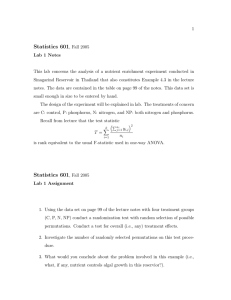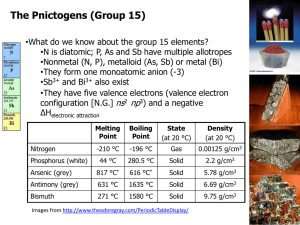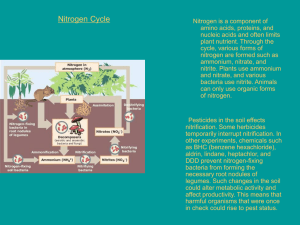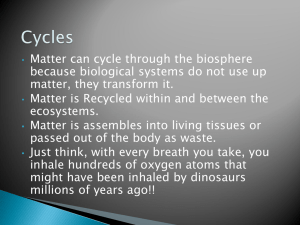CHEMISTRY 1000 Topic #2: The Chemical Alphabet Fall 2013 Dr. Tracey Roemmele
advertisement
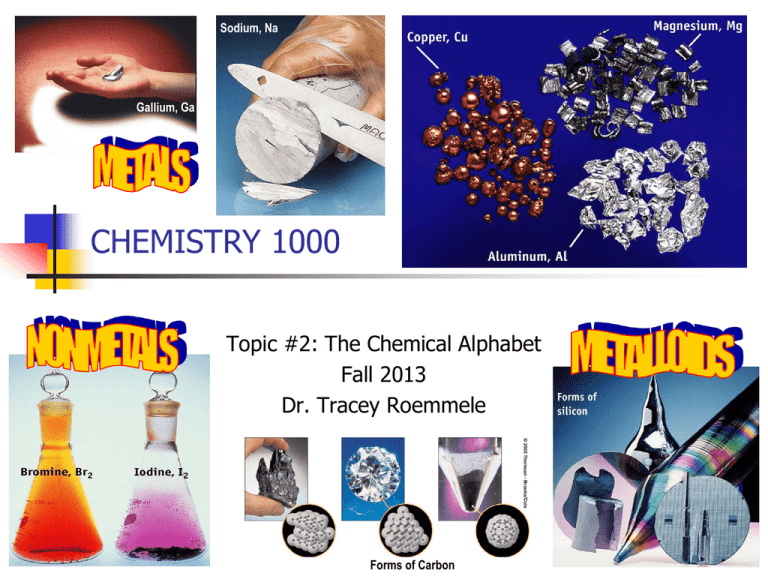
Sodium, Na Gallium, Ga CHEMISTRY 1000 Topic #2: The Chemical Alphabet Fall 2013 Dr. Tracey Roemmele Forms of Carbon The Group 15 Elements What do we know about the group 15 elements? N is diatomic; P, As and Sb have multiple allotropes Nonmetal (N, P), metalloid (As, Sb) or metal (Bi) They form one monoatomic anion (-3) Sb3+ and Bi3+ also exist They have five valence electrons (valence electron configuration [N.G.] ns2 np3) and a negative ΔHelectronic attraction Melting Point Boiling Point State (at 20 °C) Density (at 20 °C) -210 °C -196 °C Gas 0.00125 g/cm3 44 °C 280.5 °C Solid 2.2 g/cm3 Arsenic (grey) 817 °C* 616 °C* Solid 5.78 g/cm3 Antimony (grey) 631 °C 1635 °C Solid 6.69 g/cm3 Bismuth 271 °C 1580 °C Solid 9.75 g/cm3 Nitrogen Phosphorus (white) Images from http://www.theodoregray.com/PeriodicTableDisplay/ 2 Nitrogen Nitrogen is a very stable diatomic molecule (N2). The triple bond holding the two atoms together is very strong, so N2 is a very unreactive gas. Nitrogen is often used as an inert atmosphere for chemical reactions and for production of electronic components. Being the major component of air, it is much cheaper than the most common alternative, argon. (Air is 78% N2, 21% O2 and 1% Ar with traces of many other gases. See p. 212 of Petrucci for details.) As we saw earlier in the course, nitrogen will react spontaneously with lithium and with the alkaline earth metals: The reaction between nitrogen and hydrogen is exothermic, but it will not proceed without some sort of catalyst. (Some bacteria can “fix” nitrogen by making NH3 from N2, H+ and e-.) 3 Nitrogen Nitrogen is an essential element for all organisms, but most cannot use elemental nitrogen (N2), instead requiring nitrogen that has been “fixed” in some way (as a nitrate, an ammonium salt or as part of a biological molecule). The most important industrial method for making ammonia (NH3) is the Haber-Bosch process. Nitrogen and hydrogen are reacted in the presence of catalyst at a high temperature (400 oC) and high pressure (~200 bar): The reaction is forced to continue in a forward direction by removing ammonia as it is produced by cooling it to a liquid. NH3 condenses at a much higher temperature than N2 or H2. Why? The unreacted nitrogen and hydrogen are recycled back into the reaction chamber, allowing for almost 100% yield of NH3 over time.4 Nitrogen 5 Nitrogen Ammonia is a weak base. When it dissolves in water, some of the ammonia reacts with the water: For this reason, aqueous ammonia (NH3(aq)) is often referred to as ammonium hydroxide (NH4OH(aq)). Since this equilibrium is reactant-favoured, NH3(aq) is more descriptive of the solution. Ammonia reacts completely with the strong acids. It should be kept well away from nitric acid as the product of that reaction is highly explosive! What is this product? Write a balanced equation for the reaction between ammonia and nitric acid. Many other explosive compounds contain nitrogen because N2(g) is such a stable molecule that reactions producing it tend to be very exothermic. e.g. azides (N3- salts), TNT 6 Phosphorus There are two major allotropes of phosphorus: White phosphorus (P4) is soft and waxy and so reactive with air that it is stored under water. It can ignite spontaneously in air Red phosphorus (P, a network solid) is formed when white phosphorus is heated to 200 - 400 oC away from air. Black phosphorus and violet phosphorus also exist. They are both network solids. 7 Phosphorus As we saw in the halogens section, phosphorus reacts with the halogens to make PX3 which, on reaction with more halogen, makes PX5. It isn’t surprising that P4 is so reactive given its structure. Compare the bond angles in P4 to the ideal bond angles for an atom with a steric number of 4 (three bonds plus one lone pair). 8 Phosphorus Phosphorus forms strong bonds with oxygen, and there are several phosphorus oxides, phosphates, phosphites and phosphoric acids. We saw that the sulfur oxides were acidic. This can be generalized to all nonmetal oxides. The two main oxides of phosphorus are P4O6 and P4O10. What is formed when each reacts with water? Do you remember what was unusual about phosphorous acid? 9 Phosphorus Phosphoric acid is unusual among the oxoacids in that it has a tendency to polymerize. H3PO4 is “orthophosphoric acid” When two molecules of H3PO4 combine, they make “diphosphoric acid” (or “pyrophosphoric acid”) and a molecule of water: If a third molecule of H3PO4 is added to the chain, “triphosphoric acid” is produced: Two very important biological molecules (ATP and ADP) contain derivatives of these polymerized phosphoric acids. 10
